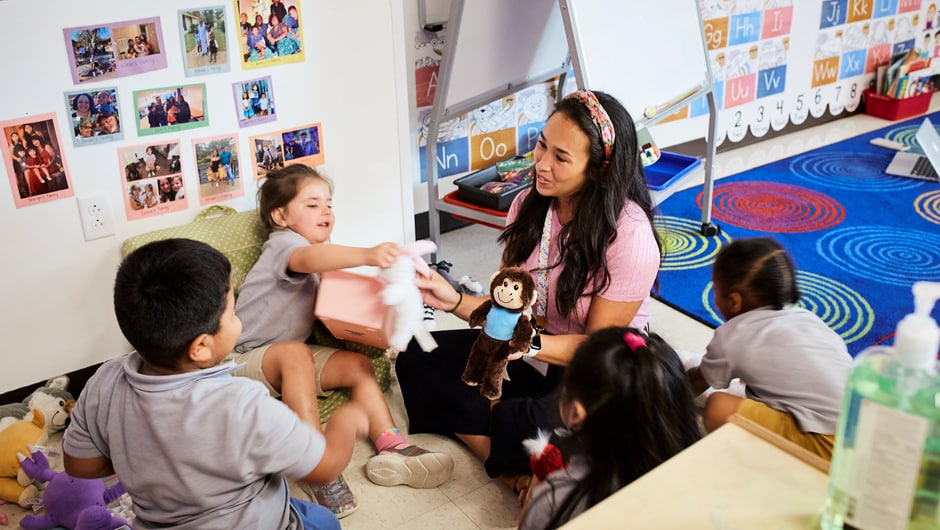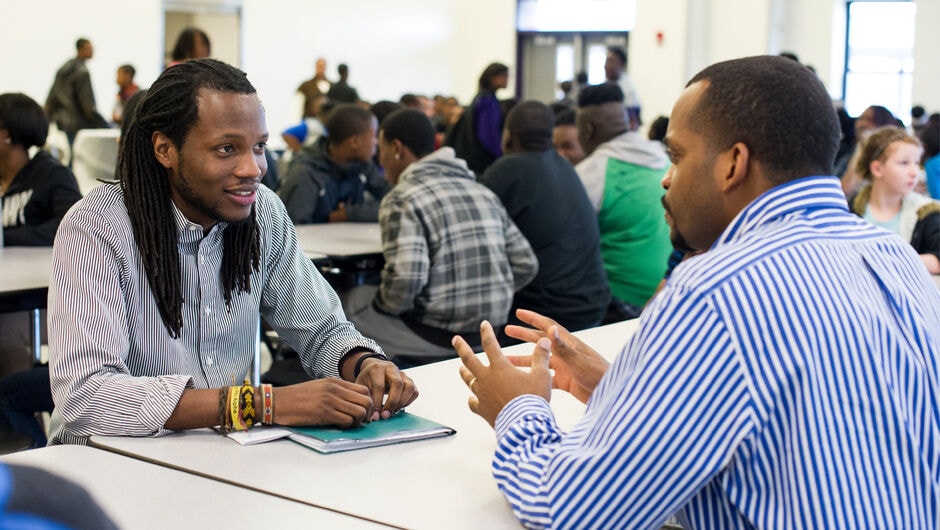Strengthening My Students’ Social-Emotional Learning through Animal-Assisted Therapy
Elementary school teacher Emily Miller (Indy ’16) shares how introducing her dog Lady as animal-assisted therapy for her students has strengthened their social-emotional learning and wellbeing.
Across Indianapolis, our education system is fostering greater innovative practices in schools that support the whole student—preparing them as culturally-conscious individuals for a highly interconnected world.
According to the Indiana Youth Institute, social-emotional learning has been demonstrated to “contribute to better health, improved school climate, increased academic achievement, improved behavior, success at work, [and] stronger relationships.”
As an organization, we’re committed to elevating innovative practices within and across schools that lead to greater long-term life outcomes for students. In her piece below, alumna Emily Miller (Indy ’16) discusses how reflecting on her students’ social-emotional needs led her to the innovative idea of bringing in animal-assisted therapy.
My classroom is just like many others: busy, loud, colorful, and full of energetic and curious five- to six-year-olds. However, it has one big difference: it has Lady, the extremely sweet, soft, eight-year-old, Black Lab/Border Collie mix therapy dog.
I’m extremely thankful to work at Global Prep Academy, which offers a multicultural two-way Spanish immersion program. Global Prep’s mission to grow global leaders through hands on learning and cultural opportunities, is completely in line with much of my own teaching beliefs. Additionally, Global Prep values social-emotional learning, through the implementation of activities and programs like Second Steps, which comes with already-made lessons that teach students about focusing their attention, listening, recognizing feelings, and calming down when they’re upset. In alignment with this developmental emphasis, our principal Mariama Shaheed was thrilled when I introduced the idea of having a therapy dog.
When I first agreed to adopt a dog, I had no idea it would lead to this. Lady was just so calm, obedient, and smart that she was naturally a therapy dog for me. Thinking about my students and their needs, I had the thought to use Lady for developing their social-emotional skills. I figured since she was such a help for my own stress and anxiety, she could also be therapeutic for them—many of whom have experienced or are experiencing trauma.
Mrs. Shaheed sent a note to all our families to hear from parents. They were all excited, and no one had any complaints, so we began preparing our kids a few weeks ahead of bringing Lady in. Knowing that Lady would be a distraction at first, I went over the rules daily. The kids were to respect the dog by being gentle and careful. They were to only pet the dog when having the dog bone pass. They were not to feed the dog. We practiced petting her on stuffed animals, and we talked about how to treat animals.
Once Lady came in, the kids adored her. They give her pets and hugs, and occasionally fight over who gets to read to her during indoor recess. I receive colorful drawings daily, which I am told are specifically for the dog, that say: “I love Lady.” Parents tell me all the time that their children talk about her constantly, and one student even named his male puppy after her.
Students have made strong behavioral progress since Lady has been here. Lady has been an amazing help to me in the classroom. She has the ability to calm down crying students immediately. Sometimes she stops meltdowns before they can even happen. One of my students with sensory processing issues will ask her to lay on him when he is feeling angry, upset, or overstimulated. She has such a calming effect on the room as a whole as well.
One day, a student was completely shutting down because a friend had cut him in line. This student needed immediate attention, and, knowing that he doesn’t respond well to teachers when he is in that state, I called Lady over. She sat down, licked his face, and put her head in his lap. After petting her for about 10 minutes, he was smiling and ready to rejoin the class.
Not only does Lady aid in their social-emotional skills, but she builds their confidence in themselves and their academics. Lady has a way of making each of them feel special, and that unconditional love is something many of them need in order to feel like they can succeed in school. For instance, some students really struggle in reading, and a lot of that comes from the belief that they can’t do it. A dog can’t judge them or tell them they are doing it wrong, and they jump at the chance to read to her. This gives them extra practice reading and builds their confidence.
Lady has been transformative for my classroom, and she is beloved by the entire school. I’m excited to see how Lady can continue to support my students in their social-emotional learning and growth.
Sign up to receive articles like this in your inbox!
Thanks for signing up!
Content is loading...








